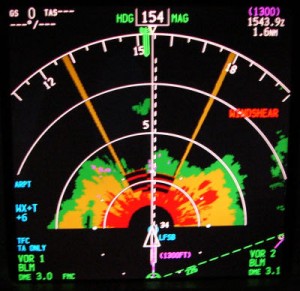Lately I’ve noticed a bunch of news coverage about flights experiencing turbulence especially after the Air France flight over the Atlantic. While as tragic as that flight was for those people, turbulence is not an uncommon thing. Anyone who has flown has probably experienced some level of turbulence. In fact it’s graded and is talked about frequently between pilots and controllers. But what cases it?
Turbulence can be caused by many different things including thunderstorms. However, turbulence doesn’t have to require a full blown storm cell to be happen. In fact some turbulence is created through other processes. Convective currents or thermals are created when the heat from large bodies of land radiate heat into the cooler air and create some pretty good bumps. I’ve flown over some really strong thermals in the heat of Texas in the summer. Those bumps made me feel like I was riding a bronco. Yee-haw!
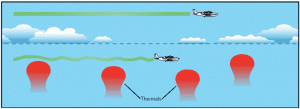
But turbulence can also be experienced when flying close to a mountain range, or at higher, cruise altitudes when an aircraft is entering or leaving the jet stream. In both of those cases the turbulence would be in clear air away from the clouds. An aircraft can experience turbulence when flying low to the ground (during take off or landing) where turbulence is formed by winds interacting with land masses and buildings or even from a larger aircraft flying in front of a smaller aircraft and creating wake turbulence.
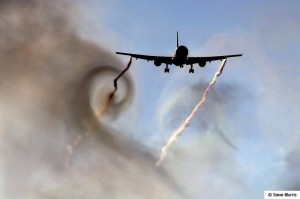
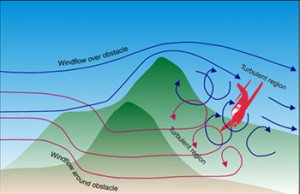
“So what is the the difference between turbulence levels and how are they defined?”
According to the Aeronautical Information Manual (AIM) there are 4 major categories of turbulence: Light, Moderate, Severe and Extreme.
|
Intensity
|
Aircraft Reaction
|
Reaction Inside Aircraft
|
Reporting Term-Definition
|
|---|---|---|---|
|
Light |
Turbulence that momentarily causes slight erratic changes in ;altitude and/or attitude (pitch, roll, yaw). Report as Light Turbulence |
Occupants may feel a slight strain against seat belts or shoulder straps. Unsecured objects may be displaced slightly. Food service may |
Occasional – Less than 1/3 of the time. Intermittent – 1/3 to 2/3. Continuous – More than 2/3. |
|
Moderate |
Turbulence that is similar to Light Turbulence but of greater intensity. Changes in altitude and/or attitude occur but the aircraft remains in positive control at all times. It usually causes variations in indicated airspeed. Report as Moderate Turbulence; 1 or Turbulence that is similar to Light Chop but of greater intensity. It causes rapid bumps or jolts without appreciable changes in aircraft altitude or attitude. Report as Moderate Chop.1 |
Occupants feel definite strains against seat belts or shoulder straps. Unsecured objects are dislodged. Food service and walking are difficult. |
NOTE
1. Pilots should report location(s), 2. Duration may be based on time |
| Severe |
Turbulence that causes large, abrupt
|
Occupants are forced violently against seat belts or shoulder straps. Unsecured objects are tossed about. Food Service and walking are impossible. |
EXAMPLES: a. Over Omaha. |
| Extreme | Turbulence in which the aircraft is violently tossed about and is practically impossible to control. It may cause structural damage. Report as Extreme Turbulence. 1 |
b. From 50 miles south of Albuquerque to 30 miles north of Phoenix, 1210Z to 1250Z, occasional Moderate Chop, Flight Level 330, DC8. |
|
| 1.High level turbulence (normally above 15,000 feet ASL) not associated with cumuliform cloudiness, including thunderstorms, should be reported as CAT (clear air turbulence) preceded by the appropriate intensity, or light or moderate chop. |
|||
Thankfully extreme turbulence is as the name implies, extremely rare and modern radar systems, weather prediction equipment and crew training make running into it almost non-existent. Pilots are encouraged to provide pilot reports (PIREP) on what their ride condition is to air traffic control to assist with other aircraft who will follow behind. PIREPS are always provided with the following information such as location (nearest VOR or point), time (in Zulu) and when observed, altitude, type of aircraft, temperature, precipitation, etc. PIREPS are so important that pilots are required to report conditions they experience that are different than forecasted.
Now reporting moderate to severe turbulence at 12,500 feet in a Cessna 172 may not be terribly important to a Boeing 757 that is transitioning through that airspace. It makes logical sense because a larger, heavier aircraft is not going to be affected by the same level of winds as a smaller, lighter aircraft would be. However if a larger aircraft is experiencing moderate turbulence, that could be severe for smaller aircraft. As part of the forecast, if there is any significant weather a AIRMET (Airman’s Meteorological Information) is released indicating potential and less severe weather conditions. These are typically referred to as weather advisories. A SIGMET (Significant Meteorological Information) is an advisory that concerns the safety of all aircraft. They can be convective SIGMETs which indicate thunderstorms or non-convective which would include severe turbulence, severe icing or dust or ash that is affecting an area of 3,000 square miles.
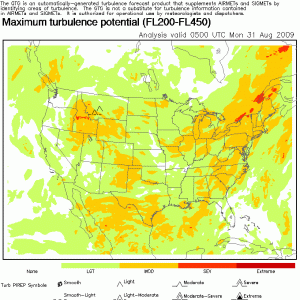
So what does all of this mean for the typical traveler on a commercial airplane? It means that even though at times the ride may be a little bumpy, that as many safety precautions are being taken as possible. For the squeamish air traveler, they should probably think of light or moderate turbulence like driving down a road that is need or repair or has a few pot holes. Nothing that will damage your vehicle, but just spoils an otherwise smooth ride. So when the pilot turns on the seat belt sign, and the flight crew tells you to return to your seats…they aren’t doing so to be a nuisance, they are doing so to protect you. It doesn’t mean that you’re going to be in a severe turbulent situation like windshear (shown on the radar below), it’s just better to be prepared for the worst and hope for the best.
